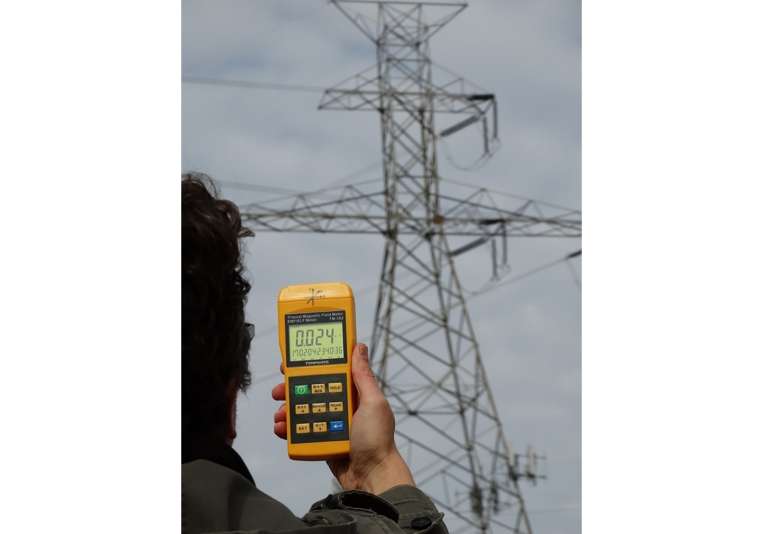Our Electric Meters
From the Series: Our Lives with Electric Things
From the Series: Our Lives with Electric Things


When I scan for Tesla with my TM-192 triaxial magnetic field meter, it probably looks like I’m playing Pokémon Go! I move across campus, through parks, and down sidewalks with that perambulatory cellphone posture: head down, eyeballs like plastic bobbers on a mirror-still lake, right elbow ajar, four fingers scooped, thumb like a bloated antenna, scouring the screen for electric crumbs. When I locate significant Tesla I pause, raise my arm: zzzzzap!
In 1901, when just 3 percent of U.S. homes had electricity, Nikola Tesla launched his Worldwide Wireless System. His most poetic vision—to manipulate the earth’s resonant frequency and the atmosphere’s standing waves to send free, wireless power between continents—was also his greatest professional failure. Nevertheless, his groundbreaking electrical inventions and contributions to physics inspired the 1960 General Conference on Weights and Measures to adopt the Tesla as the international unit of magnetic flux density.
The proliferation of smart devices exemplifies our anthropocentric entanglement with electric things—our planet has more active SIM cards than living humans. Yet our entanglements range toward invisible horizons. Electromagnetic fields shift in the spaces between the screen where you read this sentence, your wired environment, and the synapses firing in your brain. One can measure the flux density of those fields as Tesla.
My TM-192, like an oversized yellow smartphone, measures extremely low frequency fields (30 to 2000 Hertz). It displays and records the measurements in microtesla (µT), but if anyone asks, I’m looking for Tesla. Finding and measuring the various manifestations of Tesla—as inventor, as flux density, and as electric car company promoting a sustainable energy future—makes me feel a tiny pivot in a broader infrastructural turn. It allows me to register a blip in the white noise as materially profound and potentially sublime, as an electric world without wires.

Our neighbors tell us on the intercom that the men are inside the building: going apartment to apartment, slicing and sealing, leaving their victims in the dark. My father and I race downstairs to catch them, but it’s too late. All that remains are wisps of plastic cable cuticle, warm drops of red wax, and bits of wire. The silver disc inside the electricity meter is dead, the numbers unblinking, the metal box sealed by the Delhi Electricity Supply Undertaking (DESU).
In the 1990s, our electricity meter, like those of our neighbors, was frequently disconnected for nonpayment. This disconnection would follow months of inflated bills and silence from state-managed electric companies. Faulty meters, red tape, and arbitrary meter readings transformed state officials into little sovereigns with the ability to give power or deny light. Within hours of disconnection, however, our genteel middle-class building hired an electrician to illegally connect us to the mains: a reminder that illegal, but licit forms of collective agency are hardly the sole purview of subalterns. Electricity was eventually restored when DESU officials received a thick brown envelope.
The electrical is always political in India. And the meter’s political career points us to shifting circuits of power with loose connections that allow, even force, citizens to find new pathways to access the state. The electricity meter—dead or alive—produces everyday encounters with technology, infrastructure, and a postcolonial state that demand its own form of critical reading. An ostensibly simple device to measure electricity empowers and disempowers state and nonstate actors in unpredictable ways. Ten years after the electrician illegally restored our power, another man did the same and eventually became Delhi’s chief minister. No wonder, then, that meter reading is, for many, what critical reading is for scholars like us.

Electricity meters are devices that simultaneously mediate our lives with electric things and with the outside world. As electricity travels from power stations into houses and apartments, the outside becomes inside and public transmission turns into private consumption. As its name suggests, a meter is first and foremost an instrument of measurement. More akin to tachometers than to scales or thermometers, electricity meters measure flow and time (kilowatt-hours). As they measure, meters translate and render the physical world legible in numerical terms through mechanical dials or, more recently, LED screens. Measurement here is performative; it is a material-semiotic practice that produces realities, rather than merely representing them. In this sense, the electricity meter is also a passage point of a different kind, one that may operate at a number of registers—functional, semiotic, affective, symbolic.
It is in its capacity as a semiotic object that the meter also does things beyond measurement. It can assign responsibilities and produce obligations, it can chart the limits of the public and the private, and it can function within specific ethical and political assemblages. In places where the state may otherwise appear far removed, a meter can act as a marker of official recognition and belonging. In other places, it can be experienced as an object of punitive state surveillance. It is in this capacity, as a public object of sorts, that meters have been bypassed, protested, or ripped out in places like Ireland or South Africa. And yet, meters can also be thoroughly private things: instruments that measure commodities and value. Finally, this semiotic capacity of the meter may also orient our actions and shape who we are. Depending on the assemblage in which it is deployed, a meter might encourage us to see ourselves as virtuous or delinquent beings, as wasteful or prudent or market savvy, environmentally aware or financially reliable. In this sense, electricity meters not only mediate our lives with electric things and with the outside world, they may also constitute us as particular persons—as consumers, citizens, and ethical beings.